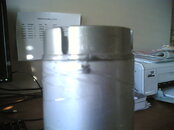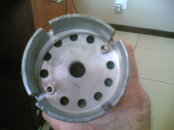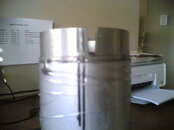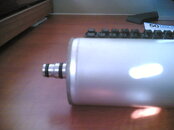widget
Contributor
Okay after some work we came to this (3 pics) conclusion.
We removed the filter top and machined an aluminium top to fit, its machined to seal inside the tube with a small lip to co-incide with the external tube dimensions.
The lug extends about 15 mm into the tube and is pinned in place with two (one on either side) pins, the idea is that we can remove the pins when the filter is spent, pull out the aluminium lug, refill and re-use the lug again, we will line up the pin holes by the lines we drew in the casing and lug, or we may have two or three lugs machined and just rotate them, so we will always have one ready packed filter.
We then drilled and tapped two small hoes at the top so we could insert the pull handle to get the filter out of the housing.
The issue we have now is length, presently we think the lug is too long (high) as it extends beyond the normal new filter length by about 6mm, so the cap of the housing wont screw down fully, but we will just machine off a bit on monday and try again, I think the housing cap just needs to snug down on the top of the filter cartridge and this will keep it in place.
It wasnt as difficult as I expected, but I think you need access to a lathe to machine a closure for the filter otherwise there is just no way to seal the top - or none that I could see or my mate think of.
Well, what do you guys think, will it work, any suggestions?
We removed the filter top and machined an aluminium top to fit, its machined to seal inside the tube with a small lip to co-incide with the external tube dimensions.
The lug extends about 15 mm into the tube and is pinned in place with two (one on either side) pins, the idea is that we can remove the pins when the filter is spent, pull out the aluminium lug, refill and re-use the lug again, we will line up the pin holes by the lines we drew in the casing and lug, or we may have two or three lugs machined and just rotate them, so we will always have one ready packed filter.
We then drilled and tapped two small hoes at the top so we could insert the pull handle to get the filter out of the housing.
The issue we have now is length, presently we think the lug is too long (high) as it extends beyond the normal new filter length by about 6mm, so the cap of the housing wont screw down fully, but we will just machine off a bit on monday and try again, I think the housing cap just needs to snug down on the top of the filter cartridge and this will keep it in place.
It wasnt as difficult as I expected, but I think you need access to a lathe to machine a closure for the filter otherwise there is just no way to seal the top - or none that I could see or my mate think of.
Well, what do you guys think, will it work, any suggestions?








